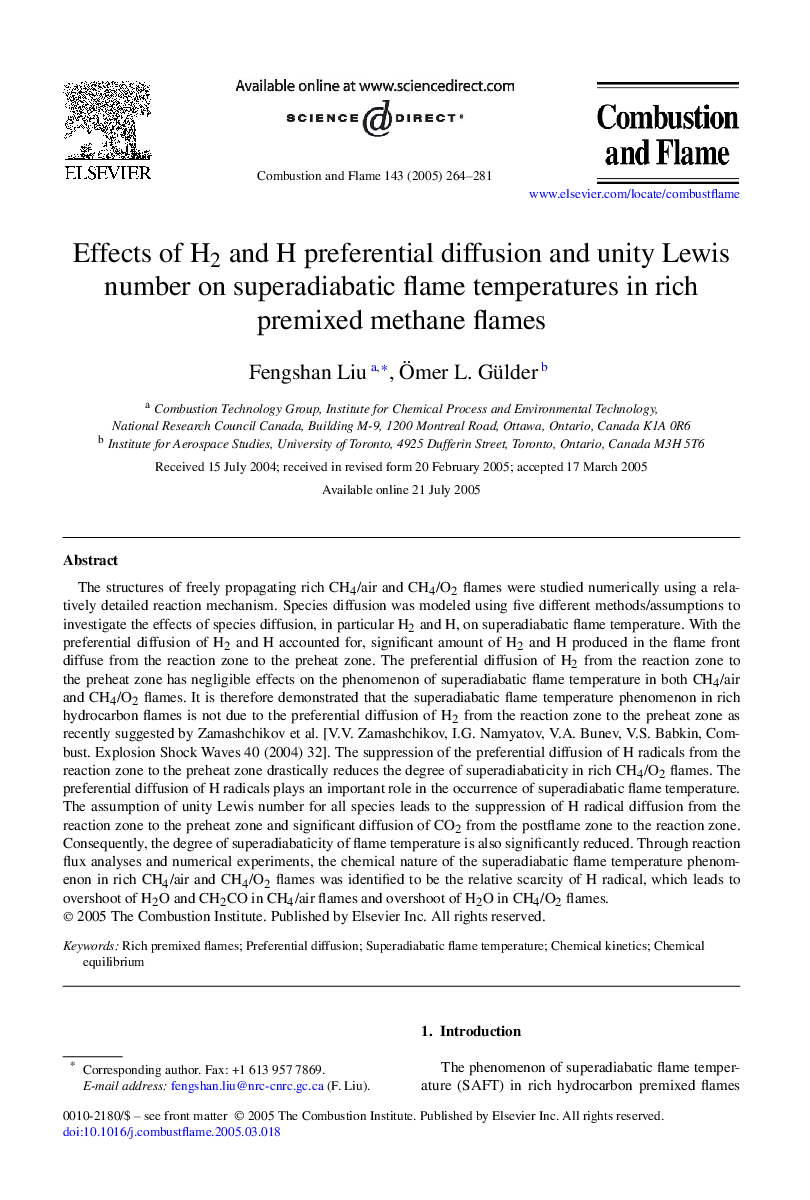| کد مقاله | کد نشریه | سال انتشار | مقاله انگلیسی | نسخه تمام متن |
|---|---|---|---|---|
| 10264517 | 457924 | 2005 | 18 صفحه PDF | دانلود رایگان |
عنوان انگلیسی مقاله ISI
Effects of H2 and H preferential diffusion and unity Lewis number on superadiabatic flame temperatures in rich premixed methane flames
دانلود مقاله + سفارش ترجمه
دانلود مقاله ISI انگلیسی
رایگان برای ایرانیان
کلمات کلیدی
موضوعات مرتبط
مهندسی و علوم پایه
مهندسی شیمی
مهندسی شیمی (عمومی)
پیش نمایش صفحه اول مقاله

چکیده انگلیسی
The structures of freely propagating rich CH4/air and CH4/O2 flames were studied numerically using a relatively detailed reaction mechanism. Species diffusion was modeled using five different methods/assumptions to investigate the effects of species diffusion, in particular H2 and H, on superadiabatic flame temperature. With the preferential diffusion of H2 and H accounted for, significant amount of H2 and H produced in the flame front diffuse from the reaction zone to the preheat zone. The preferential diffusion of H2 from the reaction zone to the preheat zone has negligible effects on the phenomenon of superadiabatic flame temperature in both CH4/air and CH4/O2 flames. It is therefore demonstrated that the superadiabatic flame temperature phenomenon in rich hydrocarbon flames is not due to the preferential diffusion of H2 from the reaction zone to the preheat zone as recently suggested by Zamashchikov et al. [V.V. Zamashchikov, I.G. Namyatov, V.A. Bunev, V.S. Babkin, Combust. Explosion Shock Waves 40 (2004) 32]. The suppression of the preferential diffusion of H radicals from the reaction zone to the preheat zone drastically reduces the degree of superadiabaticity in rich CH4/O2 flames. The preferential diffusion of H radicals plays an important role in the occurrence of superadiabatic flame temperature. The assumption of unity Lewis number for all species leads to the suppression of H radical diffusion from the reaction zone to the preheat zone and significant diffusion of CO2 from the postflame zone to the reaction zone. Consequently, the degree of superadiabaticity of flame temperature is also significantly reduced. Through reaction flux analyses and numerical experiments, the chemical nature of the superadiabatic flame temperature phenomenon in rich CH4/air and CH4/O2 flames was identified to be the relative scarcity of H radical, which leads to overshoot of H2O and CH2CO in CH4/air flames and overshoot of H2O in CH4/O2 flames.
ناشر
Database: Elsevier - ScienceDirect (ساینس دایرکت)
Journal: Combustion and Flame - Volume 143, Issue 3, November 2005, Pages 264-281
Journal: Combustion and Flame - Volume 143, Issue 3, November 2005, Pages 264-281
نویسندگان
Fengshan Liu, Ãmer L. Gülder,